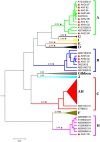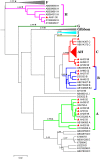Molecular Evolution and Phylodynamics of Acute Hepatitis B Virus in Japan
- PMID: 27280441
- PMCID: PMC4900519
- DOI: 10.1371/journal.pone.0157103
Molecular Evolution and Phylodynamics of Acute Hepatitis B Virus in Japan
Abstract
Hepatitis B virus (HBV) is prevalent worldwide and causes liver diseases, including acute and chronic hepatitis. Ten HBV genotypes (A-J) with distinct geographic distributions have been reported. Cases of acute HBV infection with genotype A have increased in Japan nationwide since the 1990s, mainly through sexual transmission. To investigate the molecular evolution and phylodynamics of HBV genotypes, we collected acute HBV isolates acquired in Japan from 1992-2002. Full genomes were obtained for comprehensive phylogenetic and phylodynamic analysis, with other Japanese HBV sequences from GenBank that were isolated during 1991-2010. HBV genotypes were classified using the maximum-likelihood and Bayesian methods. The GMRF Bayesian Skyride was used to estimate the evolution and population dynamics of HBV. Four HBV genotypes (A, B, C, and H) were identified, of which C was the major genotype. The phylodynamic results indicated an exponential growth between the 1960s and early 1990s; this was followed by a population bottleneck after 1995, possibly linked with successful implementation of a nationwide vaccination program. However, HBV/A increased from 1990 to 2003-2004, and then started to decrease. The prevalence of genotype A has increased over the past 10 years. Phylodynamic inference clearly demonstrates a steady population growth compatible with an ongoing subepidemic; this might be due to the loss of immunity to HBV in adolescents and people being born before the vaccination program. This is the first phylodynamic study of HBV infection in Japan and will facilitate understanding the molecular epidemiology and long-term evolutionary dynamics of this virus in Japan.
Conflict of interest statement
Figures




Similar articles
-
Molecular evolution and phylodynamics of hepatitis B virus infection circulating in Iran.Arch Virol. 2018 Jun;163(6):1479-1488. doi: 10.1007/s00705-018-3764-3. Epub 2018 Feb 13. Arch Virol. 2018. PMID: 29442226
-
Molecular epidemiology of hepatitis B virus genotypes circulating in acute hepatitis B patients in the Campania region.J Med Virol. 2014 Oct;86(10):1683-93. doi: 10.1002/jmv.24005. Epub 2014 Jul 1. J Med Virol. 2014. PMID: 24980631
-
Tracing the history of hepatitis B virus genotype D in western Japan.J Med Virol. 2006 Jan;78(1):44-52. doi: 10.1002/jmv.20502. J Med Virol. 2006. PMID: 16299716
-
Enigmatic origin of hepatitis B virus: an ancient travelling companion or a recent encounter?World J Gastroenterol. 2014 Jun 28;20(24):7622-34. doi: 10.3748/wjg.v20.i24.7622. World J Gastroenterol. 2014. PMID: 24976700 Free PMC article. Review.
-
Hepatitis B virus taxonomy and hepatitis B virus genotypes.World J Gastroenterol. 2007 Jan 7;13(1):14-21. doi: 10.3748/wjg.v13.i1.14. World J Gastroenterol. 2007. PMID: 17206751 Free PMC article. Review.
Cited by
-
Post-Vaccination and Post-Infection Immunity to the Hepatitis B Virus and Circulation of Immune-Escape Variants in the Russian Federation 20 Years after the Start of Mass Vaccination.Vaccines (Basel). 2023 Feb 13;11(2):430. doi: 10.3390/vaccines11020430. Vaccines (Basel). 2023. PMID: 36851307 Free PMC article.
-
Origin and dissemination of hepatitis B virus genotype C in East Asia revealed by phylodynamic analysis and historical correlates.J Viral Hepat. 2019 Jan;26(1):145-154. doi: 10.1111/jvh.13006. Epub 2018 Oct 17. J Viral Hepat. 2019. PMID: 30199591 Free PMC article.
-
Virus-induced hepatocellular carcinoma with special emphasis on HBV.Hepatol Int. 2017 Mar;11(2):171-180. doi: 10.1007/s12072-016-9779-5. Epub 2017 Jan 17. Hepatol Int. 2017. PMID: 28097530 Review.
-
Phylogeography of hepatitis B virus: The role of Portugal in the early dissemination of HBV worldwide.PLoS One. 2022 Dec 22;17(12):e0276618. doi: 10.1371/journal.pone.0276618. eCollection 2022. PLoS One. 2022. PMID: 36548381 Free PMC article.
-
Reconstruction of the origin and dispersal of the worldwide dominant Hepatitis B Virus subgenotype D1.Virus Evol. 2022 Apr 8;8(1):veac028. doi: 10.1093/ve/veac028. eCollection 2022. Virus Evol. 2022. PMID: 35712523 Free PMC article. Review.
References
-
- Arauz-Ruiz P, Norder H, Robertson BH, Magnius LO. Genotype H: a new Amerindian genotype of hepatitis B virus revealed in Central America. J Gen Virol. 2002;83(Pt 8):2059–73. - PubMed
-
- Kramvis A, Kew M, Francois G. Hepatitis B virus genotypes. Vaccine. 2005;23(19):2409–23. - PubMed
-
- Tatematsu K, Tanaka Y, Kurbanov F, Sugauchi F, Mano S, Maeshiro T, et al. A genetic variant of hepatitis B virus divergent from known human and ape genotypes isolated from a Japanese patient and provisionally assigned to new genotype J. J Virol. 2009;83(20):10538–47. 10.1128/JVI.00462-09 - DOI - PMC - PubMed
MeSH terms
Substances
LinkOut - more resources
Full Text Sources
Other Literature Sources
Medical
Miscellaneous

